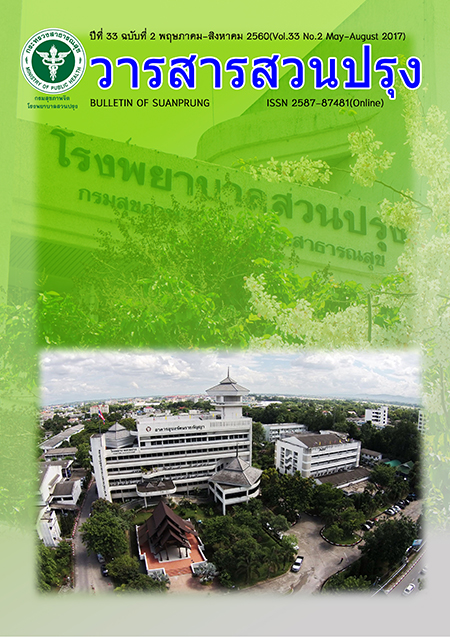การเปรียบเทียบความหวัง ความหมายในชีวิต และภาวะซึมเศร้าของผู้สูงอายุในศูนย์พัฒนา;Comparison of Hope, Meaning in Life and Depression among the Elderly at Thammapakorn Social Welfare Development Center for Older Persons in Chiang Mai
Main Article Content
Abstract
บทคัดย่อ
วัตถุประสงค์ เพื่อเปรียบเทียบและหาความสัมพันธ์ระหว่างความหวัง ความหมายในชีวิต และภาวะซึมเศร้าของผู้สูงอายุชายและหญิงในศูนย์พัฒนาการจัดสวัสดิการสังคมผู้สูงอายุบ้านธรรมปกรณ์ เชียงใหม่
วัสดุและวิธีการ กลุ่มตัวอย่างถูกคัดเลือกแบบเฉพาะเจาะจง จำนวน 45 คน รวบรวมข้อมูลด้วย แบบวัดความหวัง แบบวัดความหมายในชีวิต และแบบวัดภาวะซึมเศร้าในผู้สูงอายุไทย วิเคราะห์ข้อมูลด้วย Mann – Whitney U test, Independent Sample T-test และ Spearman Correlation Coefficient
ผล ผู้สูงอายุส่วนใหญ่มีความหวังอยู่ในระดับปานกลาง (80%) ไม่มีภาวะซึมเศร้า (64.4%) มีรูปแบบความหมายในชีวิตค่อนข้างกระจายใน 4 รูปแบบ 1) มีความหมายในชีวิตและยังคงแสวงหาความหมายในชีวิตในมุมมองอื่น ๆ (44.4%) 2) มีความหมายในชีวิตและไม่แสวงหาความหมายในชีวิตในมุมมองอื่น ๆ (22.2%) 3) ไม่มีความหมายในชีวิตแต่กำลังแสวงหาความหมายในชีวิต (6.7%) และ 4) ไม่มีความหมายในชีวิตและไม่แสวงหาความหมายในชีวิต (26.7%) เพศไม่มีผลต่อความหวัง ความหมายในชีวิต และภาวะซึมเศร้า (p > .05) นอกจากนี้พบว่า ความหวังมีความสัมพันธ์ทางบวกกับความหมายในชีวิตในระดับปานกลาง (r = .316, p < .05) ส่วนภาวะซึมเศร้ามีความสัมพันธ์ทางลบกับความหวัง (r = -.619, p < .05) และกับความหมายในชีวิตด้านมิติการรู้จักลักษณะเฉพาะตนในระดับปานกลาง (r = -.484, p < .01)
สรุป ผู้สูงอายุในสถานสงเคราะห์คนชรามีความหวังอยู่ในระดับปานกลาง ส่วนใหญ่มีความหมายในชีวิตและยังคงแสวงหาความหมายในชีวิตในมุมมองอื่น ๆ และไม่มีภาวะซึมเศร้า ความหวังมีความสัมพันธ์ทางบวกกับความหมายในชีวิต ส่วนภาวะซึมเศร้ามีความสัมพันธ์ทางลบกับความหวังและความหมายในชีวิต
Abstract
Objective To compare and examine the relationship between hope, meaning in life and depression of elderly men and women at Thammapakorn Social Welfare Development Center for Older Persons in Chiang Mai.
Materials and methods Forty-five participants were selected by purposive sampling and were asked to complete the Herth Hope Index, Meaning in Life Questionnaire and Thai Geriatric Depression Scale. Data were analyzed by The Mann – Whitney U test, Independent Sample T-test and Spearman's rank correlation coefficient.
Results Most of the sample had a moderate level (80%) and no depression (64.4%). The meaning in life were dispersed in 4 profiles: 1) The elderly had found their meaning in life and continued searching for further meaning (44.4%), 2) The elderly had found their meaning in life but did not continue searching for another meaning (22.2%), 3) The elderly had not found their meaning in life but continued searching for meaning (6.7%), and 4) The elderly had not found their meaning in life and did not continue searching for meaning (26.7%). There was no significant difference between genders on hope, meaning in life and depression (p > .05). Moreover, a moderate positive correlation was found between hope and meaning in life (r = .316, p < .05) whereas the depression was correlated negatively with hope (r = -.619, p < .01) and with presence of meaning subscale at moderate level (r = -.484, p < .01).Conclusion The majority of the elderly in this center had achieved a moderate level on the Herth Hope Index. They had found their meaning in life, continued searching for further meaning and had no depression. Hope and meaning in the life of the elderly were positively correlated but the depression was correlated negatively with the hope and the presence of meaning.
Article Details
บทความหลังผ่านการปรับแก้จากกองบรรณาธิการแล้ว เป็นลิขสิทธ์ของวารสารจิตเวชวิทยาสาร โรงพยาบาลสวนปรุง กรมสุขภาพจิต กระทรวงสาธารณสุข ห้ามเผยแพร่เพื่อประโยชน์ทางการค้าโดยไม่ได้รับอนุญาต แต่อนุญาตให้เผยแพร่บทความดังกล่าวเพื่อประโยชน์ทางการศึกษาแก่ประชาชนทั่วไป ทั้งนี้กองบรรณาธิการไม่จำเป็นต้องเห็นด้วยกับบทความหรือข้อคิดเห็นใดๆ ที่ปรากฏในวารสารสวนปรุง
